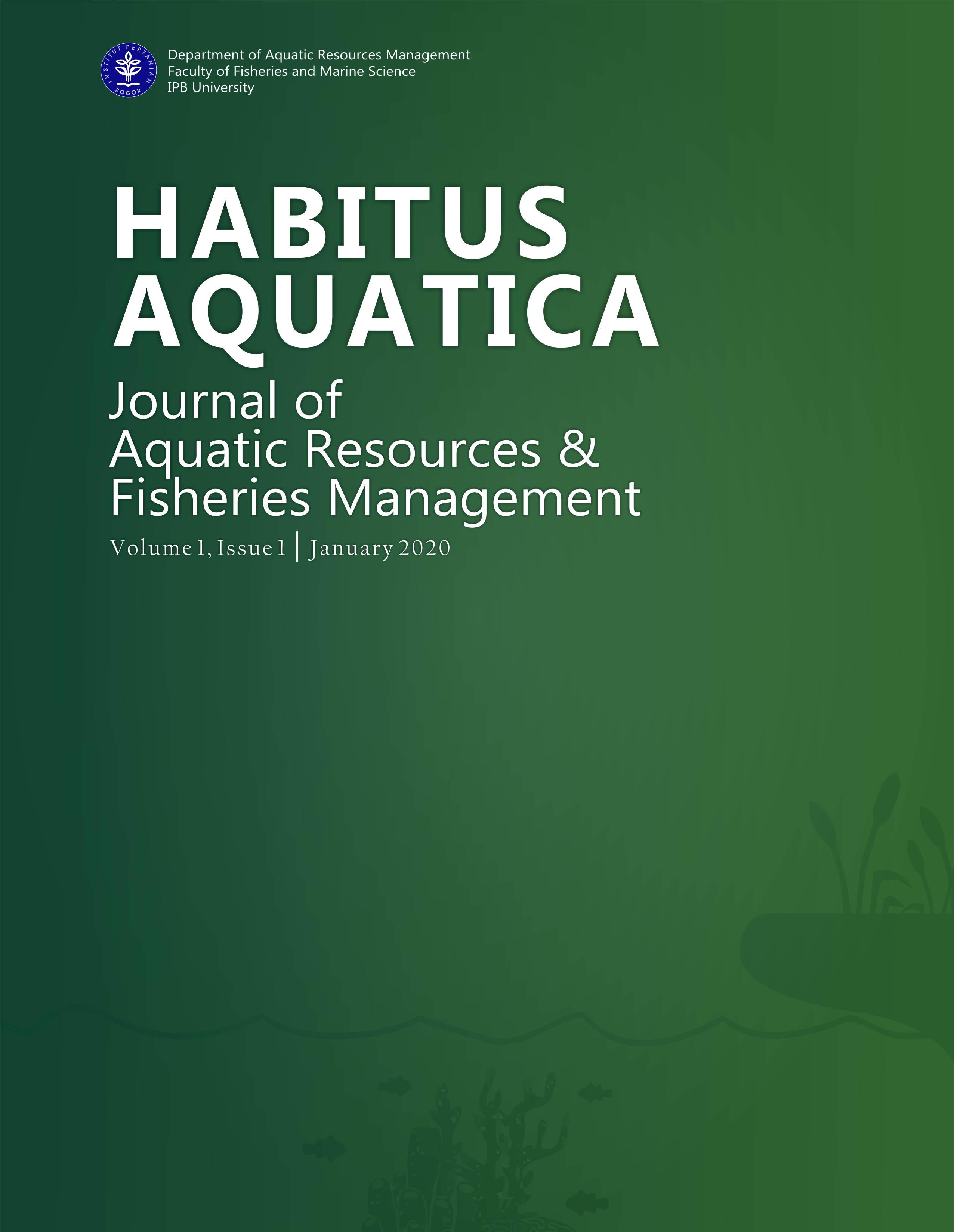Pemanfaatan dan musim penangkapan kepiting jangkang (Macrophthalmus japonicus de Haan 1835) di perairan pesisir timur Kota Surabaya
Abstract
Fishing activities on the east coast of Surabaya use a variety of simple fishing gear. One who tries to fish by picking crabs as the target of the catch. Fishermen use a sled (skilot) gliding over a stretch of mud to launch a catching target in the form of a sentinel crab (Macrophthalmus japonicus) whose carapace conditions are still soft. Crabs with hard carapace conditions are not captured by fishermen. This study aims to determine the species of sentinel crab resources the target is catching, the location of the catchment area of sentinel crabs and understand the pattern of the fishing season. The method used in the research is descriptive survei method. The study was conducted in February until July 2018. The research location was in the coastal city of Surabaya. Respondents were fishermen caught by sentinel crabs with catchment locations on the east coast of Surabaya City. To determine the type of species, samples were carried out several times on catches, each amounting to 25 sentinel crabs in soft carapace conditions. The location of the captured area is determined by the fishermen, while making a map of the location using the Arcview 3.3 program. The pattern of fishing season is done by determining the value of the Fishing Season Index (FSI). The results of the study are as follows: 1). The types of sentinel crabs that are targeted by fishermen are Macrophthalmus japonicus; 2). The fishing ground of the sentinel crab is on the tidal stretch with a muddy base in the East Coast region of Surabaya at coordinates 7014’24”–7015’05” South Latitude and 112048’09”– 112049’04” East Longitude; 3). The fishing season pattern for sentinel crabs based on the FSI is that the peak season successively takes place in the months: April(612,96%), and May (164,68%). Medium season: July (77,76 %), March (68,61%), February (64,04%), and January (59,47%). Low season: June (42,69%), November (36,59%), August (32,02%), October (18,30%), December (18,30%), and September (4,57%).
Downloads
References
Ai-Yun T, Yu-Zhi S. 1984. Macrophthalmus (Decapoda, Brachyura) of the Seas of China. Crust. 46(1):76–86.
Barnes RSK. 1966. The Status of the Crab Genus Euplax H. Milne Edwards 1852, and new genus Australoplax of the Subfamily Macrophthalminae (Brachyura: Ocypodidae). Aust. Zool. 8(4):370–378.
Febrianto A, Simbolon D, Haluan J, Mustaruddin. 2017. Pola musim penangkapan cumi-cumi di perairan luar dan dalam daerah penambangan timah Kabupaten Bangka Selatan. Marine Fisheries. 8(1):63–71.
Henmi Y. 1984. The description of wandering behavior and its occurrence, varying in different tidal areas in Macrophthalmus japonicus (De Haan) (Crustacea: Ocypodidae). Journal of Experimental Marine Biology and Ecology. 84:211–224.
Henmi Y. 1989 Life-history patterns in two forms of Macrophthalmus japonicus (Crustacea: Brachyura). Marine Biology. 101(1):53–60.
Jiang CJ, Zhu GH, Zhou QS, Qian J. 2012. Studies on benthos in the intertidal zone of sandy mud flats at Sanmen Bay, the East China Sea. Advanced Materials Research. 518–523:5138–5142.
Kekenusa JS, Watung VNR, Hatidja D. 2012. Analisis penentuan musim penangkapan ikan cakalang (Katsuwonus pelamis) di Perairan Manado Sulawesi Utara. Jurnal Ilmiah Sains. 12(2):112–119.
Komai T, Goshima S, Murai M. 1995. Crab of the genus Macrophthalmus of Phuket Thailand (Crustacea: Decapoda: Ocypodidae). Bulletin of Marine Science. 56(1):103–149.
McLay CL, Kitaura J, Wada K. 2010. Behavioural and molecular evidence for the systematic position of Macrophthalmus (Hemiplax) Hirtipes Hombron and Jacquinot, 1846, with commens on macrophthalmine subgenera (Decapoda, Brachyura, Macrophthalmidae). Studies on Malacostraca. 14:483–503.
Rahayu D and Nugroho DA. 2012. The Indonesian Species of Macrophthalmus desmarest, 1823, with the descriptionof new species (Crustacea: Decapoda: Brachyura: Macrophthalmidae). Zootaxa. 3158:20–36.
Serene R. 1973. Notes on Indo-West Pacific Species of Macrophthalmus (Crustacea, Bracyura). Zool. Med. 46(8):99–120.
Subagio H, Widagdo S. 2013. Model Pengelolaan Perikanan Tangkap pada Perikanan Artisanal Multigear di Perairan Pesisir Kota Surabaya. Penelitian Hibah DIKTI.
Subagio H. 2018. Sumber daya Kepiting Jangkang (Macrophthalmus japonicus) dan Musim Penangkapannya di Perairan Pantai Timur Kota Surabaya. Penelitian Dosen Internal. Universitas Hang Tuah. Surabaya.
Wada K. 1978. Two forms of Macrophthalmus japonicus de Haan (Crustacea: Brachyura). Publications of the Seto Marine Biological Laboratory. 24(4-6):327–340.
Zulkarnain, Wahju RI, Sulistiono. 2012. Komposisi dan estimasi musim penangkapan ikan pelagis kecil dari purse seine yang didaratkan di PPN Pekalongan, Jawa Tengah. Jurnal Saintek Perikanan. 7(2):61–70.
Copyright (c) 2020 Habitus Aquatica

This work is licensed under a Creative Commons Attribution-ShareAlike 4.0 International License.
Authors submitting manuscripts should understand and agree that copyright of manuscripts of the article shall be assigned/transferred to Habitus Aquatica Journal. This work is licensed under a Creative Commons Attribution-ShareAlike 4.0 International License (CC BY-SA). Therefore, Authors and Readers are permitted to share — copy and redistribute the material in any medium or format, and adapt — remix, transform, and build upon the material for any purpose. However, they must give appropriate credit, provide a link to the license, and indicate if changes were made. If you remix, transform or build upon the material, you must distribute your contributions under the same license as the original.



















